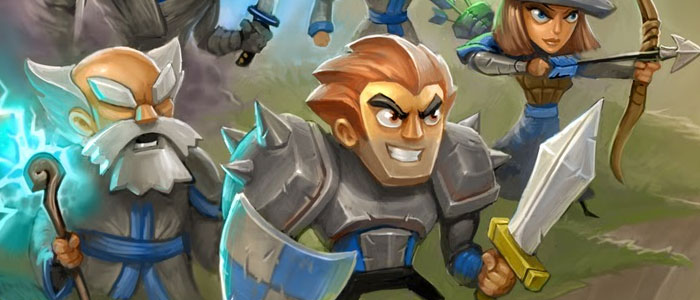[tab:Review]
As the Reviews Editor for ZTGD, I get the chance to look at every game review and editorial piece before it goes live on the site for the purposes of editing and proofreading. I’m a word and grammar nerd, and this task is something I love to do. Knowing that, it should come as no surprise that I’m a huge fan of Words with Friends. The asynchronous gameplay is perfect for playing in short bursts, and many of our readers have taken up the “Futon Challenge” (confused? Listen to an episode of N4G Radio). I’m also a big fan of competitive turn-based strategy games and, for that reason, Robot Entertainment’s Hero Academy seems like it was designed especially for me.
The most important thing to know about Hero Academy is that the core game, which comes with the Council army and in-app ads is 100% free. You can play anyone who has the game, even those that have chosen to upgrade their experience, which means that no matter how you decide to customize your experience, you’ll always have access to every competitor out there. Upgrades number among the cosmetic avatars, player colors and taunts and the more substantial new teams. Purchase a single new team (regularly priced at $1.99) and you eliminate in-app ads.

The intelligent pricing model only matters if the game is worth playing, though. I’m glad to report that Hero Academy is a brilliantly designed game that nails many of the critical user interface issues that are typically ignored in iOS game development. In Hero Academy, each player has a preset army that acts like a deck. The object of the game is to destroy your opponent’s army or his/her crystals before the same can be done unto you. At the start of the game, you are randomly dealt six pieces. These include units, attachments and one-time use healing items, magic spells and damage boosts.
Unfortunately, there is no way to take a mulligan if you get a bad hand, but at any time, you can spend one of your five actions per turn to swap a piece out. The replacements don’t show up until your hand refreshes at the end of the turn, though, so you won’t receive immediate reinforcements. In order to start the conquest of your foes, you’ll need to place your units on one of your two starting tiles on the 9×5 playing field. Placing, moving, attacking, augmenting units and swapping pieces all take an action from your pool. The best part of planning your action usage, though, is that the game features a great Undo feature, giving you infinite attempts at experimentation.
There are a number of different battlefields, all of which are symmetrical and feature different placement for defense, attack and crystal assault boost tiles. Capturing and holding these critical placements is key to victory. Each deck features five different types of heroes (including one unique Super Unit) that have different movement types, attack ranges and special features. For instance, the Council Ninja can swap places with a friendly unit. The Dark Elf Necromancer can raise fallen enemies as friendly phantoms.

In Hero Academy, knocking an enemy unit down often isn’t enough. Council Priestesses and Health Potions can bring knocked out units back into the fight, for instance. KO’d units can be revived only in the turn immediately following the knockdown. If they aren’t revived, they are removed from the battlefield permanently. Another potent strategy is to move your unit onto a KO’d enemy to stomp them, eliminating the chance of a resurrection.
Robot Entertainment has given Hero Academy a humorous and attractive art style, along with a simple but effective sound design. The slow motion knockout of an enemy unit continues to be satisfying, and there is nothing worse than the sound of an enemy unit powering up and crushing your augmented knight or archer. Unfortunately, you’ll often be learning all of these things the hard way.
My biggest complaint about the game, even after a few updates to address this, is that there is no real tutorial. There is a game guide online and, finally, an in-app YouTube video that shows some basic strategy, but no real way to test the game out without subjecting yourself to a beatdown. Hero Academy is definitely a game where hands-on experience trumps an instruction manual. Knowing movement limitations, the effects of units in combination and how best to use special abilities is something that I learned best while in a match.

Once you’ve got the hang of the game, though, I can guarantee that your biggest frustration will be friends that don’t make their moves immediately. An offline mode would go a long way to alleviating this and, maybe, we’ll see that in a future update. We are guaranteed to see additional armies, which will extend the life of the game with new strategies, matchups and trash talking.
If you have an iDevice and even a passing interest in turn-based or tabletop strategy gaming, there is absolutely no reason not to download Hero Academy. Robot Entertainment very well may have put a lock on iOS Game of the Year, and January isn’t even over yet.
Review copy of the game provided by publisher.
[tab:Screenshots]
[tab:END]
